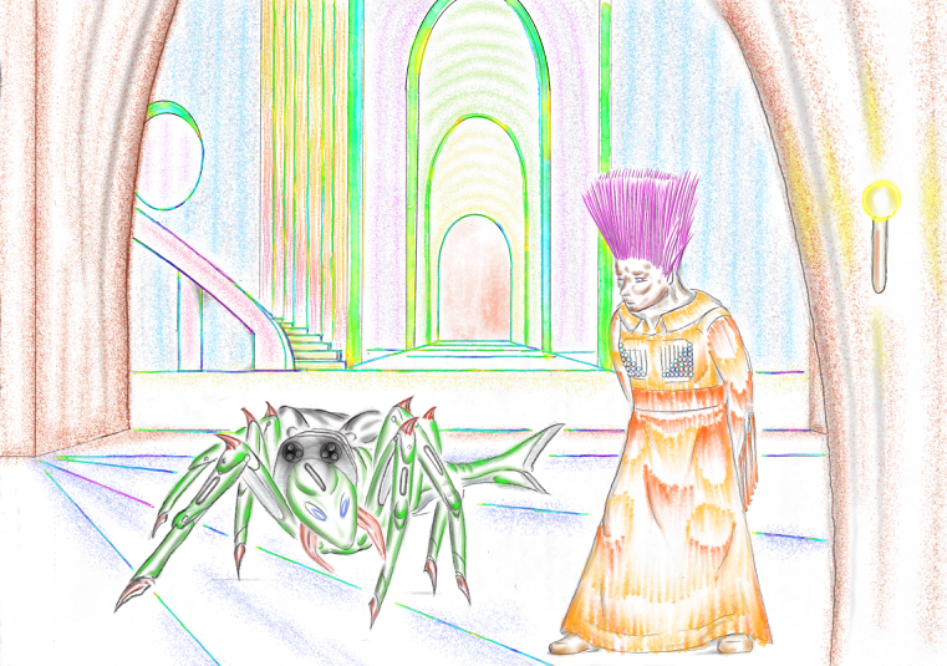Story-Art Expands Story-Clarity

Here’s a question: What were the first words ever written.
Answer: Pictures. That’s right, pictures.
Why pictures? Because pictures (illustrations) are not abstract representations of thoughts, as text is, they are mental realities.
The first simple pictographs and drawings were invented and then slowly evolved over the ages in order to satisfy ancient peoples’ need to express their thoughts and, by dint of drawing those illustrations, were also given clarity of thought as they created. Drawing and seeing their finished artwork further solidified their impressions of the landscape, the people and animals around them. Therefore, a picture is not only worth a thousand words, it is a method of visual feed-back for our imagination while we draw it.
If you are having a problem visualizing your current story, perhaps a few illustrations are just what you need to better crystallize that story in your mind, and, in the process, give yourself a healthy creative shift from text alone.
When I began my writing journey twenty years ago, I did so with the goal of writing fun and engrossing tales of adventure which, hopefully, would inspire my own kids to enjoy reading and writing too. My son and daughter have since found rewarding career-paths of their own and I am proud of all that they’ve accomplished in their lives. Thus, my dream of writing has already rewarded me.
In any event, while I wrote and created my literary worlds and became more emboldened to expand them and add more characters, I also knew that pictures in the story would keep younger minds like my children’s engaged better than words alone could. And so, something else began to evolve with the characters: my sketches. And as my sketches improved, so too did my imaginings of those characters and their situations within a particular world-setting become sharper; more exact.
Whether such clarities were directly attributable to sketching alone could be open for debate. However, I soon discovered that the more I sketched, the more enjoyable the writing became too and the more expansive the story became. The story did not just become a project to be finished, it became a wonderful, colourful and unfolding mental movie replete with conversations which flowed, quite effortlessly - first from pen to paper and then to keyboard; and the illustrations flowed just as much.
When you are drawing the landscape of your story, you are, in effect, drawing yourself further into that world in a more enjoyable way than simply “writing” the scene can accomplish on its own. That is why anyone directing a movie also likes to have pictorial storyboards drawn up beforehand. With pictures set before them, a director can better visualize and explain each scene he or she is about to shoot as the filming progresses. The only difference in writing (and drawing while writing) is that the scene and film you are shooting is the one in your mind, and the process of illustrating gives your imagination the same boost of clarity as it does for a film director.
As you begin to roughly sketch a villain or a hero in the guise in which you imagine them, you, quite literally, bring yourself face-to-face with them; and so, the feed-back loop is enhanced in your mind’s eye of their behaviour in the entirety of the story as well.
Every time you draw a sketch of a certain moment in your story, that point becomes frozen like a snap-shot which can be revisited more clearly as the story grows and develops further. You will not need to consult notes so much as reference a picture, which is much more enjoyable. Later, if you so desire, those collected, digital story-art illustrations can also be embedded into you book to enhance its appeal to the reader; but that’s for a different article.
Can I write a good story? You bet!
Can I draw? Ya...kinda.
Am I an artist? Not on your life - but that’s okay, you don’t have to be an artistic genius to create decent story-art illustrations which can visually boost your imagination. Drawing enhances visualization of your writing. Seeing further solidifies the imagining of your story.
Drawing Tips
If you can draw a line, you can begin to draw sketches of the fictional world and characters you are creating - and make them look pretty good too, thanks to - you guessed it - an app; two, to be exact. But I’m getting ahead of myself.
Pencil Sketching Tips:
· Sharpen your pencil for fine lines
· Sit comfortably and prop the sketch-pad so that it faces you directly. This prevents unconscious distortions while drawing.
· Angle the sketch-pad at a comfortable angle to your right or until your hand rests naturally on it. Of course, if you are left-handed, just mirror the angle.
· Begin at the bottom of the paper and draw upwards. Most images have a base which they grow out from and, of course, it is easier to draw up from that base than to draw down to it without error.
· Draw from left to right if you are right-handed; mirror this movement if you are left-handed. Drawing this way has a more comfortable feel and also helps prevent accidental smudging with the edge of your hand.
· When drawing straight lines, look in the direction of the draw. Looking ahead of the draw is simple eye-hand coordination which gives your hand a direction to follow. Inhaling a fresh breath each time keeps your hand steadier while drawing the line. Draw upward or left to right whenever possible as this is a steadier movement for your hand. Turn the sketch-pad not your hand.
To draw a curve, use the natural bending movement of your wrist to guide the draw. Everyone’s wrist bends through roughly 15 degrees of arc so following that arc while drawing will result in a smooth, even curve with a bit of practice. Again, turn the sketch-pad not your hand (ie: to draw a large circle).
Drawing a Story-Map:
In my experience, an overhead story-map works wonders in helping me visualize the landscape setting where the story takes place. A simple map with houses and surrounding roads and other geographic features is a great reference while describing my characters’ movements within it and keeping everything else consistent in the arc of the story. Even putting down compass coordinates - N, S, E, W - in the corner of the map adds to that story-consistency, and regularly viewing that map further solidifies the story’s physical setting in my mind.
If simple sketches kept in a sketch-pad are enough reference for you to satisfactorily complete your book, then, you need not read further. However, if you would love to create digital illustrations with added colour and pop, read on!
Tip: To sketch on a tablet, add a matte screen protector. This will eliminate bothersome reflections and have a more natural feel with the stylus.
Scanning to your tablet:
If you’re only interested in creating simple, digital, black-and-white sketches, I highly recommend the ‘Auotodesk Sketchbook’ app - either for iPad or Android tablets. This app is easy to learn to use and has an ingenious feature which enables you to scan a sketch directly to the app so you can immediately begin shading and enhancing it with a stylus.
Separate digital ‘layers’ can be added so that mistakes can be corrected or erased with ease while the other layers are unaffected. A layer can also be duplicated which brings fainter pencil lines into sharper focus for tracing with a stylus. Afterward, the original penciling can remain or be deleted for a cleaner image. A simple illustration can be drawn, imported to the app and greatly improved upon in just ten minutes or less before being shared or inserted into a doc.
Additional features such as a sliding straight edge; bendable edge; drafting protractor and adjustable ovals are nice extras too for crisp, easy-to-draw lines and curves.
Procreate Your Art.
For extra colours and texture effects, nothing beats ‘Procreate’ for iPad, in my opinion, so, after you have done everything you wish on Autodesk, import your illustration to Procreate.
There are a broad spectrum of “brush” types and textures to choose from which can be adjusted in size and opacity as you become more familiar with the app’s features. Airbrushes for shading and 3-D effect; neon-bright luminance pens; glitter and crystal effects; smudging colours together; cloud, nebula and aurora-mist effects; charcoals and various pencilling styles - these are only a few examples of the artistic touches that one can employ at any desired degree to your original sketch for extra colour and eye-catching pop.
Once you become proficient enough at augmenting your simple sketches with these two apps, each illustration shouldn’t take more than twenty minutes from start to finish; ten minutes for black-and-whites. These digitized story-art illustrations can then be shared on social media platforms, as well, to invite further attention to your works which text alone cannot accomplish.
In Conclusion...
When you begin to illustrate your story, your mind and imagination experience a sharp, pleasant feed-back-loop into the nature of that story. (1) You are drawn into and can better visualize your story’s whole environment and (2) those snap-shot images act as excellent references to further solidify that environment in your imagination.
An additional benefit that I have discovered in teaching myself to illustrate is that my imagination is given a different “flavour” of creativity. I was able to give myself permission to take a pause from the singular medium of text only and shift my mind-set over to a completely pictorial one. And so, another unexpected outcome was greater clarity in my writing as well.
So give it a go and I bet you’ll have more fun writing too.
Thank you.
Cheers!
G.F.Brynn
Deep Sky Stories & Illustrations
Deepskystories.com ✨🚀
Related posts
Story-Art Expands Story-Clarity
Here’s a question: What were the first words ever written.
Answer: Pictures. That’s right, pictures.
Why pictures? Because pictures (illustrations) are not abstract representations of thoughts, as text is, they are mental realities.
The first simple pictographs and drawings were invented and then slowly evolved over the ages in order to satisfy ancient peoples’ need to express their thoughts and, by dint of drawing those illustrations, were also given clarity of thought as they created. Drawing and seeing their finished artwork further solidified their impressions of the landscape, the people and animals around them. Therefore, a picture is not only worth a thousand words, it is a method of visual feed-back for our imagination while we draw it.
If you are having a problem visualizing your current story, perhaps a few illustrations are just what you need to better crystallize that story in your mind, and, in the process, give yourself a healthy creative shift from text alone.
When I began my writing journey twenty years ago, I did so with the goal of writing fun and engrossing tales of adventure which, hopefully, would inspire my own kids to enjoy reading and writing too. My son and daughter have since found rewarding career-paths of their own and I am proud of all that they’ve accomplished in their lives. Thus, my dream of writing has already rewarded me.
In any event, while I wrote and created my literary worlds and became more emboldened to expand them and add more characters, I also knew that pictures in the story would keep younger minds like my children’s engaged better than words alone could. And so, something else began to evolve with the characters: my sketches. And as my sketches improved, so too did my imaginings of those characters and their situations within a particular world-setting become sharper; more exact.
Whether such clarities were directly attributable to sketching alone could be open for debate. However, I soon discovered that the more I sketched, the more enjoyable the writing became too and the more expansive the story became. The story did not just become a project to be finished, it became a wonderful, colourful and unfolding mental movie replete with conversations which flowed, quite effortlessly - first from pen to paper and then to keyboard; and the illustrations flowed just as much.
When you are drawing the landscape of your story, you are, in effect, drawing yourself further into that world in a more enjoyable way than simply “writing” the scene can accomplish on its own. That is why anyone directing a movie also likes to have pictorial storyboards drawn up beforehand. With pictures set before them, a director can better visualize and explain each scene he or she is about to shoot as the filming progresses. The only difference in writing (and drawing while writing) is that the scene and film you are shooting is the one in your mind, and the process of illustrating gives your imagination the same boost of clarity as it does for a film director.
As you begin to roughly sketch a villain or a hero in the guise in which you imagine them, you, quite literally, bring yourself face-to-face with them; and so, the feed-back loop is enhanced in your mind’s eye of their behaviour in the entirety of the story as well.
Every time you draw a sketch of a certain moment in your story, that point becomes frozen like a snap-shot which can be revisited more clearly as the story grows and develops further. You will not need to consult notes so much as reference a picture, which is much more enjoyable. Later, if you so desire, those collected, digital story-art illustrations can also be embedded into you book to enhance its appeal to the reader; but that’s for a different article.
Can I write a good story? You bet!
Can I draw? Ya...kinda.
Am I an artist? Not on your life - but that’s okay, you don’t have to be an artistic genius to create decent story-art illustrations which can visually boost your imagination. Drawing enhances visualization of your writing. Seeing further solidifies the imagining of your story.
Drawing Tips
If you can draw a line, you can begin to draw sketches of the fictional world and characters you are creating - and make them look pretty good too, thanks to - you guessed it - an app; two, to be exact. But I’m getting ahead of myself.
Pencil Sketching Tips:
· Sharpen your pencil for fine lines
· Sit comfortably and prop the sketch-pad so that it faces you directly. This prevents unconscious distortions while drawing.
· Angle the sketch-pad at a comfortable angle to your right or until your hand rests naturally on it. Of course, if you are left-handed, just mirror the angle.
· Begin at the bottom of the paper and draw upwards. Most images have a base which they grow out from and, of course, it is easier to draw up from that base than to draw down to it without error.
· Draw from left to right if you are right-handed; mirror this movement if you are left-handed. Drawing this way has a more comfortable feel and also helps prevent accidental smudging with the edge of your hand.
· When drawing straight lines, look in the direction of the draw. Looking ahead of the draw is simple eye-hand coordination which gives your hand a direction to follow. Inhaling a fresh breath each time keeps your hand steadier while drawing the line. Draw upward or left to right whenever possible as this is a steadier movement for your hand. Turn the sketch-pad not your hand.
To draw a curve, use the natural bending movement of your wrist to guide the draw. Everyone’s wrist bends through roughly 15 degrees of arc so following that arc while drawing will result in a smooth, even curve with a bit of practice. Again, turn the sketch-pad not your hand (ie: to draw a large circle).
Drawing a Story-Map:
In my experience, an overhead story-map works wonders in helping me visualize the landscape setting where the story takes place. A simple map with houses and surrounding roads and other geographic features is a great reference while describing my characters’ movements within it and keeping everything else consistent in the arc of the story. Even putting down compass coordinates - N, S, E, W - in the corner of the map adds to that story-consistency, and regularly viewing that map further solidifies the story’s physical setting in my mind.
If simple sketches kept in a sketch-pad are enough reference for you to satisfactorily complete your book, then, you need not read further. However, if you would love to create digital illustrations with added colour and pop, read on!
Tip: To sketch on a tablet, add a matte screen protector. This will eliminate bothersome reflections and have a more natural feel with the stylus.
Scanning to your tablet:
If you’re only interested in creating simple, digital, black-and-white sketches, I highly recommend the ‘Auotodesk Sketchbook’ app - either for iPad or Android tablets. This app is easy to learn to use and has an ingenious feature which enables you to scan a sketch directly to the app so you can immediately begin shading and enhancing it with a stylus.
Separate digital ‘layers’ can be added so that mistakes can be corrected or erased with ease while the other layers are unaffected. A layer can also be duplicated which brings fainter pencil lines into sharper focus for tracing with a stylus. Afterward, the original penciling can remain or be deleted for a cleaner image. A simple illustration can be drawn, imported to the app and greatly improved upon in just ten minutes or less before being shared or inserted into a doc.
Additional features such as a sliding straight edge; bendable edge; drafting protractor and adjustable ovals are nice extras too for crisp, easy-to-draw lines and curves.
Procreate Your Art.
For extra colours and texture effects, nothing beats ‘Procreate’ for iPad, in my opinion, so, after you have done everything you wish on Autodesk, import your illustration to Procreate.
There are a broad spectrum of “brush” types and textures to choose from which can be adjusted in size and opacity as you become more familiar with the app’s features. Airbrushes for shading and 3-D effect; neon-bright luminance pens; glitter and crystal effects; smudging colours together; cloud, nebula and aurora-mist effects; charcoals and various pencilling styles - these are only a few examples of the artistic touches that one can employ at any desired degree to your original sketch for extra colour and eye-catching pop.
Once you become proficient enough at augmenting your simple sketches with these two apps, each illustration shouldn’t take more than twenty minutes from start to finish; ten minutes for black-and-whites. These digitized story-art illustrations can then be shared on social media platforms, as well, to invite further attention to your works which text alone cannot accomplish.
In Conclusion...
When you begin to illustrate your story, your mind and imagination experience a sharp, pleasant feed-back-loop into the nature of that story. (1) You are drawn into and can better visualize your story’s whole environment and (2) those snap-shot images act as excellent references to further solidify that environment in your imagination.
An additional benefit that I have discovered in teaching myself to illustrate is that my imagination is given a different “flavour” of creativity. I was able to give myself permission to take a pause from the singular medium of text only and shift my mind-set over to a completely pictorial one. And so, another unexpected outcome was greater clarity in my writing as well.
So give it a go and I bet you’ll have more fun writing too.
Thank you.
Cheers!
G.F.Brynn
Deep Sky Stories & Illustrations
Deepskystories.com ✨🚀
The Digital Revolution: The Impact and Advantages of eBooks
Introduction
In the age of technology and connectivity, eBooks have revolutionized the way we read and access literature. These digital books have transformed the publishing industry, making it easier than ever for readers to access a vast array of content on various electronic devices. In this article, we will explore the world of eBooks, discussing their impact on the literary landscape and the many advantages they offer to both readers and authors.
The Rise of eBooks
eBooks, short for electronic books, are digital versions of printed books that can be read on electronic devices such as e-readers, tablets, smartphones, and computers. While the concept of eBooks dates back to the early days of computing, it was the introduction of dedicated e-readers like the Amazon Kindle and the Barnes & Noble Nook in the mid-2000s that marked a significant turning point in the eBook industry.
Since then, eBooks have seen explosive growth, with millions of titles available in various digital formats. This growth can be attributed to several factors:
Accessibility: eBooks can be downloaded instantly from online stores, allowing readers to access their favorite books at any time, from anywhere in the world. This has been especially beneficial for individuals with mobility issues or those living in remote areas with limited access to physical bookstores.
Cost-Effectiveness: eBooks are often cheaper than their print counterparts. Publishers save on printing and distribution costs, which can lead to lower prices for consumers. Additionally, many classic and public domain books are available for free.
Convenience: eReaders and other digital devices can store thousands of eBooks in one compact device, eliminating the need for bulky bookshelves. Readers can carry their entire library with them, making it easy to switch between books or reference materials on the go.
Customization: eBooks offer various features such as adjustable font sizes, background colors, and bookmarks, allowing readers to tailor their reading experience to their preferences.
Environmental Impact: By reducing the demand for physical paper and transportation, eBooks contribute to environmental sustainability.
Self-Publishing: eBooks have democratized the publishing industry, enabling authors to self-publish their work without the need for traditional publishing houses. This has led to a surge in independent authors and diverse voices in literature.
Impact on the Publishing Industry
eBooks have had a profound impact on the traditional publishing industry. Publishers have had to adapt to the digital landscape by incorporating eBooks into their catalogs and distribution strategies. While there was initial concern that eBooks might cannibalize print sales, they have instead expanded the market and provided new opportunities for publishers to reach a global audience.
Furthermore, eBooks have enabled authors to reach readers directly through self-publishing platforms like Amazon Kindle Direct Publishing (KDP), Apple iBooks, and others. This has empowered writers to maintain creative control, earn higher royalties, and reach niche audiences that may not have been possible through traditional publishing channels.
Advantages for Readers
Portability: eBook readers can carry a whole library in their pocket, making it easy to read on commutes, vacations, or during downtime.
Searchability: eBooks offer a search function that allows readers to find specific keywords or phrases instantly, enhancing research and reference capabilities.
Accessibility: eBooks can be customized for readers with visual impairments, with features like text-to-speech and adjustable fonts.
Highlighting and Note-taking: Readers can highlight passages and make digital notes within eBooks, simplifying the process of studying or sharing insights.
Synchronization: Many eBook platforms offer synchronization across multiple devices, allowing readers to seamlessly switch between devices while retaining their progress.
Conclusion
eBooks have undoubtedly transformed the way we consume literature, providing numerous advantages to both readers and authors. Their accessibility, affordability, and versatility have made them a cornerstone of modern reading habits. While print books will always have their place, eBooks have carved out a significant and permanent niche in the literary world. As technology continues to advance, we can expect even more exciting developments in the world of eBooks, further enhancing the reading experience for all.





